
MOBA games have been around for a long time, but Dota 2 and League of Legends are the first to regularly pull numbers like the 329,977 concurrent users on Dota 2 and the " over 500,000 peak concurrent players every day on just the EU West" League of Legends server.
You'd think that with the sheer popularity of MOBA games, they'd be easy to break into, but that's usually not the case. Fortunately, this guide is here to help! This article should help you understand the basic concepts that are common to both games as well as the overarching differences.
Already a veteran, but looking to make the switch to LoL or Dota? Find out just what makes the two games so incredibly different.
Start Here
Both Riot's LoL and Valve's Dota 2 are free-to-play games. League of Legends is available here and Dota 2 is available here .
Be warned, both of these games have pretty steep learning curves, but it shouldn't take long to grasp the basics.
Glossary
The biggest gaming news, reviews and hardware deals
Keep up to date with the most important stories and the best deals, as picked by the PC Gamer team.
- MOBA : Multiplayer Online Battle Arena, a mix between RTS and action with players controlling a single, main character.
- Creep or Minion : AI-controlled monsters that are regularly spawned to push down the various lanes.
- Farm : The act of killing minions to collect gold; also refers to the number of minions you've killed.
- Lane : The paths that run along the top, middle and bottom of the map; also refers to the minion waves in the lane.
- Laning Phase : The part of the game where players stay in their respective lanes to farm.
- Pushing : Autoattacking and using abilities to kill enemy minions more quickly which causes the lane to literally push towards the enemy turrets.
- Split Push : When one or two players split off from the team to push a lane somewhere else on the map.
- b : Back—used to tell someone to be careful, literally move back, or return to base.
- Skillshot : An ability that needs to be aimed.
- Carry : A hero or champion that is farmed or fed and can carry a team to victory.
Basic Gam eplay
If you've ever played any sort of RTS, then the basic layout of LoL and Dota should be at least somewhat familiar. These are top-down games where you control your champion or hero alongside four other players in five-on-five fantasy action.
Left-clicking selects units while right-clicking moves your character or attacks. League of Legends uses Q, W, E and R for your main abilities with D and F reserved for summoner spells. Items are assigned to 1-6 by default. Dota 2 does things a little differently with the number keys reserved for control groups—similarly to StarCraft—and Z, X, C, V, B and N bound to your item slots. Some champions with more than four abilities also require the use of other keys like D and F.
Last hitting—delivering the killing blow to a minion—is likely the most fundamental skill you'll have to learn to play either game. Last-hitting minions is your primary means of accruing gold. Wait until the minion gets low enough for you to kill it with a single attack before you hit it. You'll still earn a slow trickle of gold over time, but killing a few extra minions can be the difference between buying the item that you need or missing out on XP for nothing.
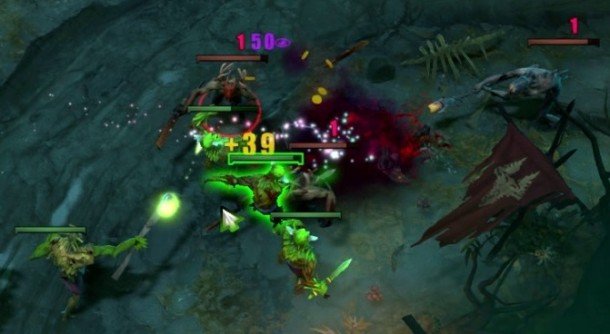
LoL and Dota 2 do differ in how they reward players for killing players. In both games, killing an enemy player grants gold to everyone who participated in the kill. In League of Legends, the amount of gold a player is worth depends on how many times they've died without getting a kill and whether or not they're on a killing spree. Dota 2 adds to this by punishing the dead player by throwing away some of the unreliable gold that they've earned. Reliable gold is awarded for kills while unreliable gold is gained over time and for killing minions.
The distinction between the two types of gold is reason enough to declare that Dota 2 is a far more punishing game. At the same time, getting kills is quite a bit more rewarding than it is in League of Legends because you gain reliable gold while causing an enemy to lose gold. Not only is it easier to make mistakes in Dota 2, but it's also harder to come back from them.
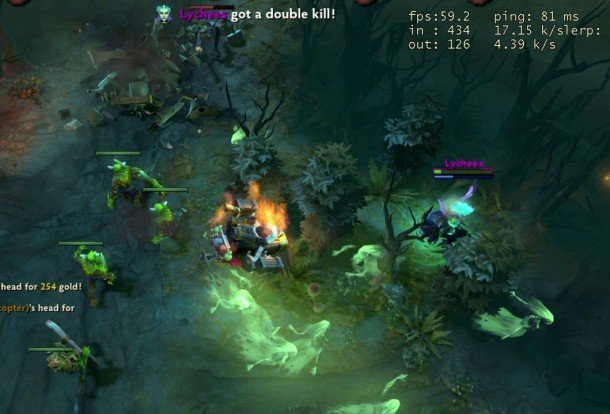
Every single match of Dota 2 or League begins with the laning phase. This generally lasts from the time that minions spawn to anywhere from 15 to 30 minutes into the game. During this time, carry characters spend their time trying to last hit as well as possible. The goal of laning phase is to earn as much gold as possible while harassing your opponent.
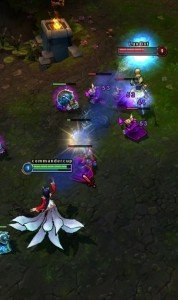
Battles are more frequent and abrupt in Dota 2. Once a team commits to a fight, enemies will be stunned and spells will be unleashed. It usually only takes a second or two for the first casualty in a fight. During a game, it's not uncommon to see first blood claimed only a few minutes in. Fights in Dota 2 are quite a bit like food fights—you look around to make sure no one's watching, then let loose a few cups of pudding or an Arcane Bolt or two.
League of Legends is a little less chaotic. The first kill might take place 10 minutes into a match, but that isn't to say that the game is any slower paced. You'll be casting your spells far more often than you do in Dota 2 because of LoL's emphasis on skillshots and low mana costs. Laning is usually a matter of last hitting while throwing out a spell or two to try and push your opponent out of lane.
The later section of both games is reserved for team fighting and coordinated pushes to try and reach the enemy base. As the end of the game approaches, teams usually start to stick together to knock down towers and eventually the base structures—the melee and ranged barracks in Dota 2 and the inhibitors in LoL which strengthens creep waves. Destroying the nexus or ancient is the only way to end the game without forcing a surrender vote.
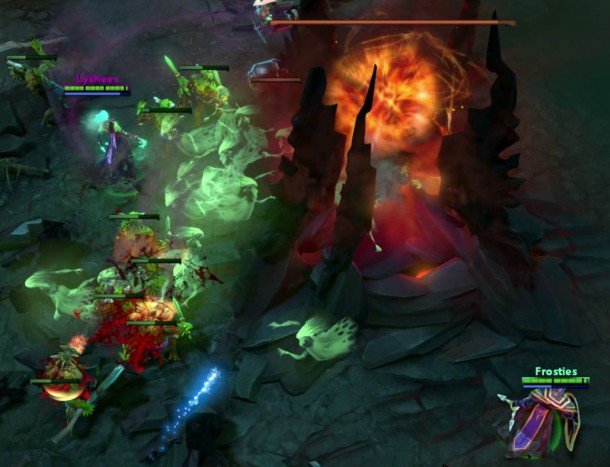
Champions/Heroes
Although you're given control over a single character in both Dota 2 and LoL, the two games have different ideas of what constitutes a hero or champion.
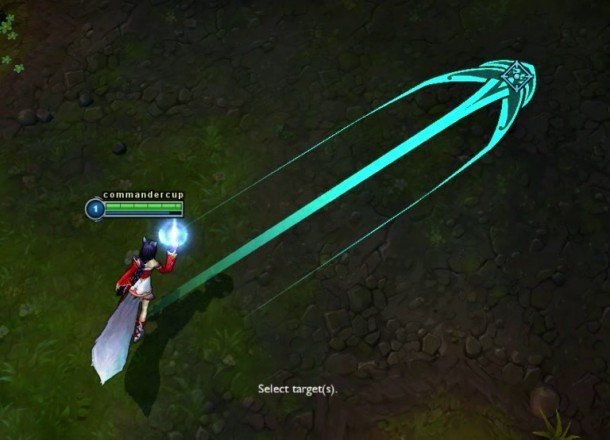
Champions in League of Legends are more likely to have skillshots and spells that can be spammed. As a result, LoL focuses not only on traditional, attack damage (AD) carries, but also on ability power (AP) carries. Unlike in Dota 2, you can buy items that increase the damage output of your abilities in LoL. The laning phase in League games usually involve quite a bit more ability-based harass. Poking your opponent with a skillshot or target spell is reasonable because of the low mana costs that accompany most spells. Every single champion in this game has four main, character-specific spells along with room for two summoner spells; Flash is one spell that you'll see all the time because it lets you jump a short distance in the direction of your cursor.

The comparatively lesser emphasis on skillshots doesn't mean that Dota 2 isn't a skill-driven game. It makes up for it by having a diverse pool of heroes that are able to build items to satisfy different roles. Dota heroes have much more explosive power with the ability to execute combos that usually leads to battles that last only a few seconds. These powerful spells come at a cost—the mana required to cast these spells is usually high—which prevents them from being used constantly. Another distinguishing factor of Dota 2's hero pool is the Invoker—playable proof of the wide variety of heroes available in the game. With a total of 14 abilities at his disposal, the Invoker is considered by many to be the most complex character in any MOBA game. Mixing and matching reagents to invoke new spells demonstrates just how versatile and varied Dota 2 heroes can be.
Next page: A quick peek at the map, metagame and itemization options in both games.

